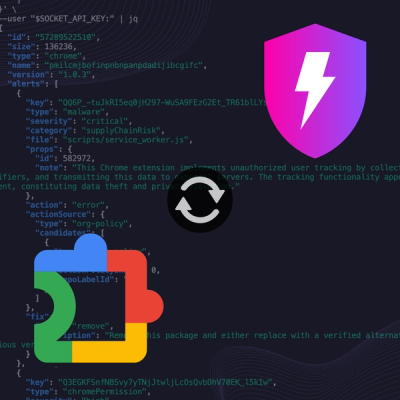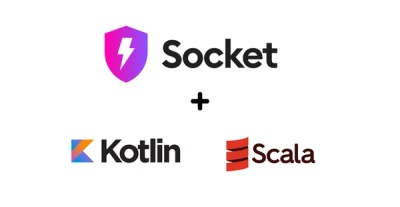
Product
Socket Now Protects the Chrome Extension Ecosystem
Socket is launching experimental protection for Chrome extensions, scanning for malware and risky permissions to prevent silent supply chain attacks.
A tox <https://tox.readthedocs.io/en/latest/>__ plugin which runs one or
more Docker <https://www.docker.com/>__ containers during the test run.
Links: Source Code <https://github.com/tox-dev/tox-docker>__ |
Documentation <https://tox-docker.readthedocs.io/en/latest/>__
.. image:: https://dev.azure.com/dcrosta/tox-docker/_apis/build/status/tox-dev.tox-docker?branchName=master :target: https://dev.azure.com/dcrosta/tox-docker/_build?definitionId=1&_a=summary :alt: Build Status
tox loads all plugins automatically. To use tox-docker, pip install it
into the same Python environment as you install tox into, whether that's a
virtualenv, etc.
You do not need to do anything special when running tox to invoke tox-docker, however you do need to configure your project to configure docker containers (see "Configuration" below).
Each docker container you want to run must be configured via a
[docker:container-name] section. The container-name is a name you
choose which must start with a letter and consist of only letters, numbers,
dots, hyphens, and underscores. Each [docker:container-name] section must
contain at least an image directive, which must name a Docker image <https://docs.docker.com/glossary/#image>__ as you'd pass to docker run; or a build directive, containing the path to a Dockerfile <https://docs.docker.com/glossary/#dockerfile>__ as you'd pas to
docker build::
[docker:db]
image = postgres:9-alpine
# OR
[docker:app]
dockerfile = {toxinidir}/Dockerfile
Then, in your [testenv], use the docker directive to list containers
you wish to run during those tests::
[testenv]
docker =
db
commands = ...
The [docker:container-name] section may contain the following directives:
image
The Docker image <https://docs.docker.com/glossary/#image>__ to run.
This value is passed directly to Docker, and may be of any of the forms
that Docker accepts in eg docker run. One of image or
dockerfile is required.
dockerfile
Path to a Dockerfile <https://docs.docker.com/glossary/#dockerfile>__
to build and run. One of dockerfile or image is required.
dockerfile_target
Name of the build-stage to build in a multi-stage Dockerfile. An error
is raised if dockerfile_target is set without dockerfile set.
environment
A multi-line list of KEY=value settings which is used to set
environment variables for the container. The variables are only available
to the container, not to other containers or the test environment.
expose
A multi-line list of port mapping specifications, as
ENV_VAR=CONTAINER_PORT/PROTO. Within the testenv, the environment
variable ENV_VAR will contain the port number to connect to the
docker container's EXPOSE d port. If expose is specified, only
the listed ports will have environment variables created for them.
If ``expose`` is not specified, all the container's ``EXPOSE`` d ports
are made available (equivalent to ``docker run -P ...``) using default
environment variable names of the form
``<container-name>_<port-number>_<protocol>_PORT`` (eg ``NGINX_80_TCP_PORT``
or ``TELEGRAF_8092_UDP_PORT``), with the container name and protocol
converted to upper case, and non-alphanumeric characters replaced with an
underscore (``_``).
host_var
The name of an environment variable that will contain the hostname or IP
address to use to communicate with the container. Defaults to
<container_name>_HOST if not set, with the container name converted to
upper case, and non-alphanumeric characters replaced with an underscore
(_).
links
A multi-line list of container links <https://docs.docker.com/network/links/>__, as other-container-name
or other-container-name:alias. If no alias is given, the
other-container-name is used. Within the container, the EXPOSE d
ports of the other container will be available via the alias as hostname.
When using links, you must specify containers in the correct start order
in the ``docker`` directive of your testenv -- tox-docker does not attempt
to resolve a valid start order.
volumes
A multi-line list of volumes <https://docs.docker.com/storage/volumes/>__ to make available to the
container, as <type>:<options>:<outside_path_or_name>:<inside_path>.
The type must be bind, and the only supported options are rw
(read-write) or ro (read-only). The outside_path_or_name must
be a path that exists on the host system. Both the outside_path
and inside_path must be absolute paths.
healthcheck_cmd, healthcheck_interval, healthcheck_retries, healthcheck_start_period, healthcheck_timeout
These set or customize parameters of the container health check <https://docs.docker.com/engine/reference/builder/#healthcheck>__. The
healthcheck_interval, healthcheck_start_period, and
healthcheck_timeout are specified as a number of seconds.
healthcheck_cmd is an argv list which must name a command and
arguments that can be run within the container; if not specified, any
health check built in to the container is used.
If any healthcheck parameters are defined, tox-docker will delay the
test run until the container reports healthy, and will fail the test
run if it never does so (within the parameters specified).
All Docker container configuration is specified in tox.ini, but some
aspects of tox-docker's behavior can be changed at run-time:
--docker-dont-stop=CONTAINER
After the test run, don't stop & remove the named CONTAINER --
leaving the container running allows manual inspection of it, eg via
docker exec .... May be specified multiple times to leave several
containers running.
Since version 4, tox-docker adds a suffix to the name of running containers, so that parallel invocations of tox may succeed (eg on a busy CI server). The details of the name suffix are not specified, and may change in a future version -- you should not rely on the details of the generated name.
Even with unique container names, parallel runs may still fail, if you map a static exposed port number for a container (as the tox host will not let two processes bind the same port).
.. code-block:: ini
[testenv:integration-tests]
deps = pytest
commands = py.test {toxinidir}/tests
docker =
db
appserv
[docker:db]
image = postgres:11-alpine
# Environment variables are passed to the container. They are only
# available to that container, and not to the testenv, other
# containers, or as replacements in other parts of tox.ini
environment =
POSTGRES_PASSWORD=hunter2
POSTGRES_USER=dbuser
POSTGRES_DB=tox_test_db
# The healthcheck ensures that tox-docker won't run tests until the
# container is up and the command finishes with exit code 0 (success)
healthcheck_cmd = PGPASSWORD=$POSTGRES_PASSWORD psql \
--user=$POSTGRES_USER --dbname=$POSTGRES_DB \
--host=127.0.0.1 --quiet --no-align --tuples-only \
-1 --command="SELECT 1"
healthcheck_timeout = 1
healthcheck_retries = 30
healthcheck_interval = 1
healthcheck_start_period = 1
# Configure a bind-mounted volume on the host to store Postgres' data
# NOTE: this is included for demonstration purposes of tox-docker's
# volume capability; you probably _don't_ want to do this for real
# testing use cases, as this could persist data between test runs
volumes =
bind:rw:/my/own/datadir:/var/lib/postgresql/data
[docker:appserv]
# You can use any value that `docker run` would accept as the image
image = your-registry.example.org:1234/your-appserv
# Within the appserv container, host "db" is linked to the postgres container
links =
db:db
# Expose ports to the testenv
expose =
APP_HTTP_PORT=8080/tcp
If you are running in a Docker-In-Docker environment, you can override the address
used for port checking using the environment variable TOX_DOCKER_GATEWAY. This
variable should be the hostname or ip address used to connect to the container.
Tox-docker requires tox to be run in Python 3.8 or newer, and requires tox version 4 or newer. Older versions of tox-docker may work with older versions of Python or tox, but these configurations are no longer supported.
Some configuration options were removed:
New in 5.0:
ports
This directive was removed in tox-docker version 5.0. Use expose
instead. The ability to map a container port to a specific host port was
completely removed.
ports; add expose and host_vardocker (the Python module) 7.x (thanks @jonathangreen)dockerfile and dockerfile_target directives
to build local images[docker:container-name]
sectionsTox-docker uses black and isort to enforce style standards on the codebase.
The formatting is ordinarily done for you via pre-commit <https://pre-commit.com/>_, and is enforced via the tox -e style build.
To work on tox-docker locally with pre-commit, `pip install -r
dev-requirements.txtandpre-commit installto set up the git hooks; subsequently, when yougit commit, the formatter will be run. If the changed files are not conformant, the hook will have reformatted them and you may need to run pre-commit again. You can run pre-commit run --files
*.py`` to manually run the formatters.
FAQs
Manage lifecycle of docker containers during Tox test runs
We found that tox-docker demonstrated a healthy version release cadence and project activity because the last version was released less than a year ago. It has 1 open source maintainer collaborating on the project.
Did you know?

Socket for GitHub automatically highlights issues in each pull request and monitors the health of all your open source dependencies. Discover the contents of your packages and block harmful activity before you install or update your dependencies.

Product
Socket is launching experimental protection for Chrome extensions, scanning for malware and risky permissions to prevent silent supply chain attacks.

Product
Add secure dependency scanning to Claude Desktop with Socket MCP, a one-click extension that keeps your coding conversations safe from malicious packages.

Product
Socket now supports Scala and Kotlin, bringing AI-powered threat detection to JVM projects with easy manifest generation and fast, accurate scans.